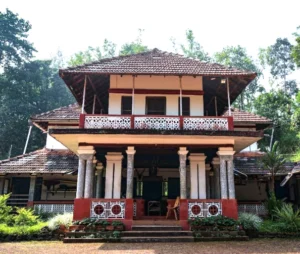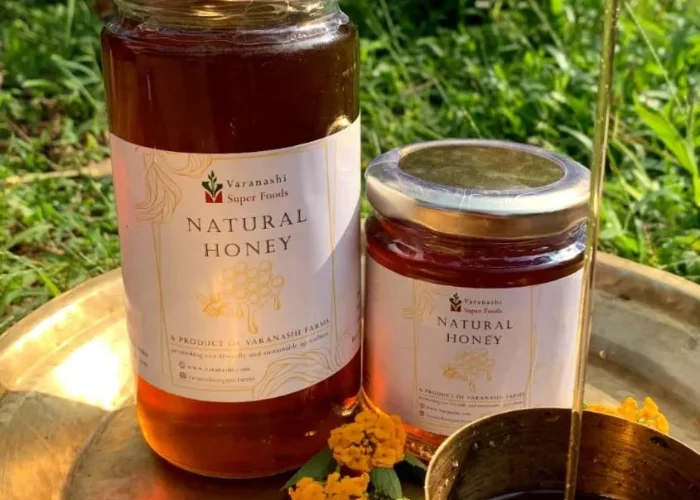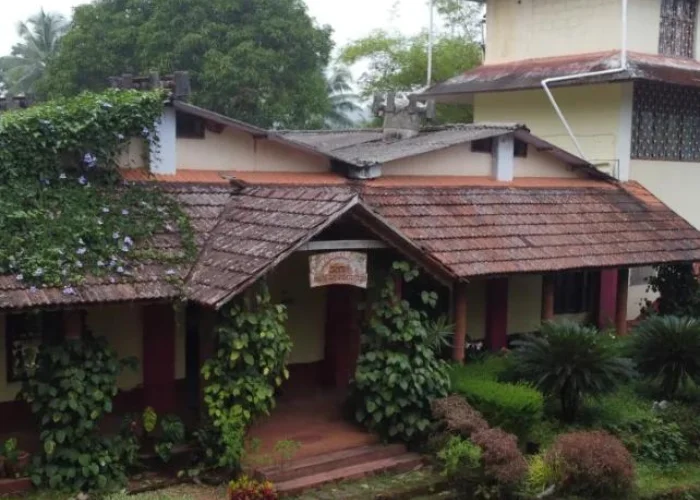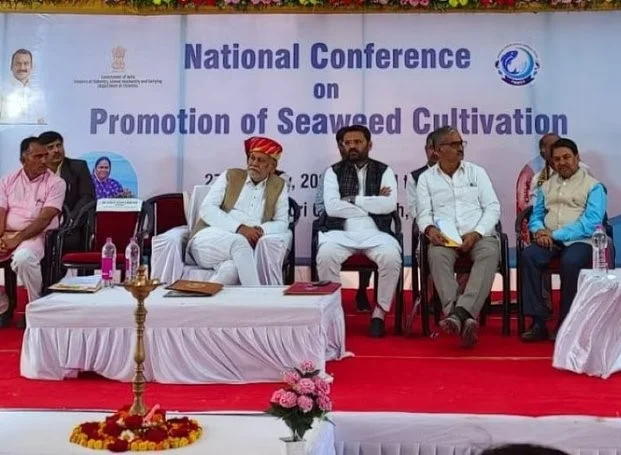In the village of Kepu in Karnataka, there’s a 50-acre organic farm that’s been around for about 200 years. It’s located around 50 kilometers southeast of Mangaluru. Over the years, this land has gone through quite a transformation. Initially, it was just a piece of green land owned by a single family, but now it’s a place where different cultures come together to visit.
With a legacy spanning six generations, Partha Varanashi is the current custodian of this land, and his roots in agriculture run deep. He explains, “My family has always had a strong interest in farming. Back in 1960, my grandfather actually started a society for farmers called CampCo. Both my parents were also very involved in studying agriculture. My dad pursued a PhD in Microbiology, while my mom focused on Macrobiology.”

As Partha grew up on this very land, he has witnessed its various changes and developments throughout the years.
A novel concept
For the past three decades, the Varanashi family has been opening their farm’s doors to guests and relatives, but they never considered doing it as a business until something happened that changed their perspective.
Back in 2006, a few of Partha’s friends paid a visit to the farm. During this time, one of his friends mentioned a young girl who had recently finished her 12th grade and was uncertain about her future plans. When she heard about Partha’s farm, she expressed interest in coming over to spend a couple of weeks to understand how things worked on a farm.

“She stayed on our land for two weeks, and during that time, she developed a strong passion for agriculture and organic farming. Eventually, she decided to study horticulture engineering,” he remembers.
This experience got Partha pondering. He thought, “If farm life could inspire just one person, there’s a good chance that other urban individuals might also enjoy and appreciate this lifestyle. It could offer a refreshing escape from the usual daily grind.”
With this idea in mind, the family approached the Karnataka Tourism Department with a proposal to promote agritourism. They made the decision to launch their farm stay venture in 2014.
Partha also mentions that the concept of inviting volunteers came to him in 2007, while he was pursuing a degree in Molecular Biology in Australia. “Over there, they have a concept called WWOOFing, where people interested in experiencing farm life can volunteer to work on farms in exchange for meals and accommodation.” The Varanashi family embraced this idea of mutual benefit and started inviting volunteers to their farm in 2014.
The ABCs of organic farming
During your stay, we encourage you to get involved in hands-on activities related to organic farming, like gathering crops, planting seeds, and processing harvested produce. You’ll even learn how to turn leftover farm materials into natural fertilizers that enrich the soil. The farm is lush with paddy fields, coconut trees, pepper vines, and various spice plants.
Don’t worry about meals – we’ve got that covered! If you decide to join our program, you’ll be treated to delicious and wholesome meals. Almost all the food we serve to volunteers, around 95%, comes directly from our abundant vegetable and fruit gardens.
Over a span of 21 days, you’ll get a solid introduction to the essentials of organic farming. During this time, you’ll have the chance to explore the farm with Partha and his family, along with local experts. They’ll break down the concept of regenerative farming, highlighting the drawbacks of chemical fertilizers and offering eco-friendly alternatives. A highlight of the experience is the cacao trail, where you’ll follow the journey of chocolate creation from bean to bar. For those interested, there’s also a five-day certification course available for Rs 20,000.
If you’re keen on making the most of your time here, Partha and his team have more to offer. They provide training in life-saving techniques like first aid and CPR, as well as recreational activities such as swimming, kayaking, and trampolining. Certified instructors lead these sessions to ensure your safety and enjoyment.

Participation in all the activities is free to try out, but there’s a fee for obtaining certifications if you’re interested.
Water Management for Sustainable Farming
At Varanashi Farm, the significance of water management transcends the basic needs of irrigation. Acknowledging the delicate balance between excess water leading to diseases and scarcity posing a threat to crops, the farm employs innovative water management practices that contribute to both agricultural success and environmental sustainability.
A prominent feature of Varanashi Farm’s water management strategy is the intricate network of drainage channels interspersed throughout the terrain. These channels, strategically spaced every eight to ten feet, create a zigzag pattern across the farm. This intentional design ensures that water touches a maximum surface area, mitigating the risks associated with stagnant or excess water. Observing these channels meandering through the farm reveals a thoughtful approach to optimizing water distribution.

As water traverses the zigzagging channels, it not only prevents waterlogging but also facilitates absorption into the groundwater. This enriched groundwater plays a pivotal role in sustaining the farm’s ecosystem. The roots of various plants, aided by the introduction of vascular mycorrhizae, specifically the glomeru species, form an underground mycelial network. This network connects disparate plant roots and facilitates the efficient movement of water between them. The integrated approach ensures that water availability is optimized for all plants across different sections of the farm.
The Art of Multi-Layer Farming
Varanashi Farm’s commitment to sustainable agriculture extends to the practice of multi-layer farming, a technique that embraces diversity and optimizes sunlight utilization. Recognizing the pivotal role sunlight plays in plant growth, the farm has strategically designed a multi-layered canopy, where each crop plays a unique role in capturing sunlight at different levels.
The farm’s canopy unfolds like a harmonious symphony, with each layer strategically positioned to capture sunlight efficiently. At the top tier, towering coconut and jackfruit trees act as the first receivers of sunlight, reaching for the skies at impressive heights. Below them, the nutmeg trees, with a height of around 20 feet, catch the sunlight that filters through the taller canopy above.

The multi-layered design continues as you descend, encountering banana plants with their large leaves that capture the remaining sunlight. The carefully orchestrated order is clear—Jackfruit, coconut, arecanut, nutmeg, banana, and finally, cacao. This sequential arrangement ensures that every level of the canopy receives its share of sunlight, leaving minimal sunlight to reach the ground.
The strategic positioning of crops not only optimizes sunlight but also acts as a natural weed deterrent. With minimal sunlight reaching the ground, the farm experiences limited weed growth. Additionally, the leaves of jackfruit, coconut, arecanut, banana, cacao, and other crops fall to the ground, creating a rich layer of organic matter. This leafy carpet becomes a feast for microorganisms, bugs, insects, and centipedes, kickstarting the process of organic matter decomposition.

The fallen leaves undergo a fascinating transformation orchestrated by microorganisms. Initially consumed by bugs and insects, the organic matter gradually transforms into bioavailable nutrients. Nitrogen, phosphorus, potash, and other essential micro and secondary nutrients are released into the soil. This nutrient-rich soil, a result of the microbial alchemy, becomes a source of nourishment for the roots of various crops, completing the cyclical journey of organic matter from the ground to plant roots and back into the soil.
An unforgettable journey
Partha talks about how the treehouse is the highlight of their stay. It’s an impressive structure standing at a towering 55 feet high, and what’s fascinating is that it seems to hang in the air without any visible support underneath.
According to Partha, this treehouse was constructed by locals. It features a single room with a spacious king-size bed and a functional work table. When you step onto the balcony, you’re greeted by a stunning view—a 55-foot drop and an expansive green landscape.

Staying in this unique treehouse costs Rs 6,000 per night, which covers both accommodation and meals. Partha shares that they typically host around four groups of guests each month. Additionally, their farm welcomes about 15 volunteers every month.
Anupama Augustine, a member of a group of research scholars from the University of Kerala and one of the volunteers who visited the farm, describes the experience as a return to nature and self-discovery. She praises Partha’s guided farm tour and interactive sessions for revealing the intricacies of regenerative farming and the farm’s cultural significance. She also emphasizes how the experience helped her appreciate the value of nature more.

Apart from providing a tranquil green oasis for urban dwellers, Partha emphasizes their commitment to sustainability. They recycle farm waste into compost and utilize a biogas unit on the land. Additionally, they’ve installed solar panels producing 7.5kW and 2.5kW of power, alongside eight natural ponds and an 80-foot well for rainwater harvesting. About 55 members of the Kepu village community are actively involved in various farm tasks such as cooking, cleaning, and producing bio-fertilizers.
Despite the positive atmosphere at Varanashi farms, there’s one challenge that Partha acknowledges—the relationship between city residents and village locals. He explains that some locals struggle to connect with volunteers from the city, and a few have even lodged complaints with the police, feeling puzzled about why city dwellers would come to work on a farm.
To bridge this gap, the Varanashi family organizes workshops and discussions like the recent ‘A Day in the Mud’, aimed at explaining the purpose behind their volunteer programs to the villagers.
However, the urban volunteers are quite enamored with life at the farm. Partha shares that they’ve hosted volunteers from 15 different countries, spanning places like the USA, Canada, France, Germany, the UK, Scotland, Australia, Japan, and Vietnam.

Looking ahead, the Varanashi family envisions creating cottages on the farm, allowing families to spend quality time together in this serene setting.
Reflecting on the transformation of the land over the past few years, Dr. Varanashi Krishna Moorthy, Partha’s father, expresses pride in what it has become. He finds joy in seeing the land he grew up on now providing a space for numerous people to take a break from their daily routines.
If you’re interested in volunteering, the cost for a 28-day package is Rs 5,000. Volunteers will be expected to contribute six hours of work daily.
To get in touch with the Varanashi family, click here









